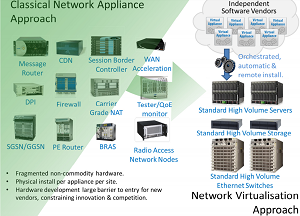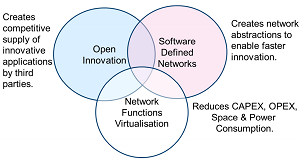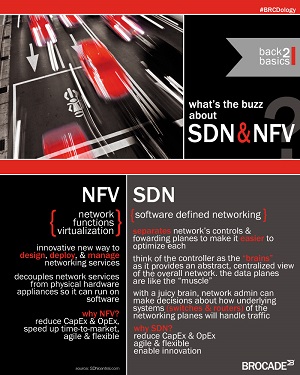News
The Rise of Network Functions Virtualization
Learn all about the younger cousin of SDN, transforming networks near you.
As the networking industry is being transformed by the next-generation virtualization approach called software-defined networking (SDN), the complementary architectural concept of network functions virtualization (NFV) is gaining more prominence.
Regular readers of Virtualization and Cloud Review Magazine may have noticed that SDN basically had the new-age networking spotlight all to itself in the early days of the ongoing network revolution. But lately, both "SDN" and "NFV" have been featured in more headlines. For example, in just the past few weeks we've reported on:
To explore why this is happening, here's a primer on NFV -- what it does, how it got started, and how it will affect an enterprise datacenter near you -- if it hasn't already.
Defining NFV
Wikipedia's crowd-sourced definition of NFV states it's "a network architecture concept that uses the technologies of IT virtualization to virtualize entire classes of network node functions into building blocks that may connect, or chain together, to create communication services."
The OpenStack Foundation, the organization behind the open source OpenStack cloud computing platform, says this: "Simply put, it's a new way to define, create, and manage networks by replacing dedicated network appliances with software and automation."
The closest thing to an official NFV governing steward, the non-profit European Telecommunications Standards Institute (ETSI), characterizes NFV as an antidote to problems caused by the increasing variety of legacy, proprietary, hardware-based networking components that are ill-fitted to meet the demands of modern computing (cloud computing, Big Data, mobility, Internet of Things and so on). They can be hard to deploy into and integrate with existing systems, and they hit the bottom line with short lifecycles causing equipment upgrade and replacement headaches, all the while potentially stifling innovation.
 [Click on image for larger view.] The Difference in Approaches (source: ETSI).
[Click on image for larger view.] The Difference in Approaches (source: ETSI).
ETSI says NFV aims to address such problems "by evolving standard IT virtualization technology to consolidate many network equipment types onto industry standard high volume servers, switches and storage. It involves implementing network functions in software that can run on a range of industry standard server hardware, and that can be moved to, or instantiated in, various locations in the network as required, without the need to install new equipment."
What NFV Does
Like SDN, NFV is fundamentally about the shift from proprietary hardware-based solutions to more open, software-based substitutes. For example, instead of a dedicated firewall appliance (typically costing $200 or $300), the same functionality can be supplied by software via a virtual firewall, one of many available Virtual Network Functions (VNFs).
Other VNFs provide intrusion detection and intrusion prevention, network address translation (NAT), load balancing, WAN acceleration, caching, Gateway GPRS Support Nodes (GGSN), Session Border Controllers, domain name services (DNS) and many more. Sometimes, different sub-functions can be combined to form a higher-level, multi-component VNF, such as a virtual router.
Furthermore, just as SDN and NFV can be implemented on inexpensive, bare-metal or white-box servers, these VNFs can run on general-purpose, commodity hardware components, instead of more expensive proprietary devices where specific functionality is baked in. NFV also lets network operators quickly locate and work with VNFs and automate service delivery via orchestration.
ETSI, which has formed an NFV Industry Specification Group, says NFV provides benefits to network operators and their customers such as:
- Reduced operator CAPEX and OPEX through reduced equipment costs and reduced power consumption
- Reduced time-to-market to deploy new network services
- Improved return on investment from new services
- Greater flexibility to scale up, scale down or evolve services
- Openness to the virtual appliance market and pure software entrants
- Opportunities to trial and deploy new innovative services at lower risk
The Origins of NFV
An ETSI group basically introduced NFV to the world in October 2012 in a white paper titled "Network Functions Virtualization -- An Introduction, Benefits, Enablers, Challenges & Call for Action." With contributions from major players ranging from AT&T to Verizon, the paper was presented at the SDN and OpenFlow World Congress conference in Germany.
The primary objective of the paper was "to outline the benefits, enablers and challenges for Network Functions Virtualization (as distinct from Cloud/SDN) and the rationale for encouraging an international collaboration to accelerate development and deployment of interoperable solutions based on high volume industry standard servers."
Furthermore, the white paper says, "Network Functions Virtualization aims to transform the way that network operators architect networks by evolving standard IT virtualization technology to consolidate many network equipment types onto industry standard high volume servers, switches and storage, which could be located in datacenters, network nodes and in the end user premises." Also, the white paper announced the formation of the aforementioned Industry Specification Group under the auspices of ETSI.
Since then, other groups have formed in attempts to guide and instill some order in the burgeoning movement. For example, the Open Platform for NFV (OPNFV) "facilitates the development and evolution of NFV components across various open source ecosystems. Through system level integration, deployment and testing, OPNFV creates a reference NFV platform to accelerate the transformation of enterprise and service provider networks."
NFV and SDN
Having only been introduced less than five years ago, NFV is younger than its disruptive cousin, SDN, which according to Wikipedia originated shortly after Java was released by Sun Microsystems in 1995, though the "first SDN test" reportedly occurred in 2001. Whatever way you look at it, SDN is much older than NFV, but how do the two movements fit together?
 [Click on image for larger view.] NFV and SDN (source: ETSI).
[Click on image for larger view.] NFV and SDN (source: ETSI).
ETSI says NFV and SDN are highly complementary but not inter-dependent. As explained in our SDN primer, the vendor-agnostic Open Networking Foundation (ONF) -- which bills itself as "a user-driven organization dedicated to the promotion and adoption of SDN through open standards development" -- says SDN is "the physical separation of the network control plane from the forwarding plane, and where a control plane controls several devices." Furthermore, it's "an emerging architecture that is dynamic, manageable, cost-effective and adaptable, making it ideal for the high-bandwidth, dynamic nature of today's applications."
 [Click on image for larger view.] Brocade's Take on NFV and SDN (source: Brocade).
[Click on image for larger view.] Brocade's Take on NFV and SDN (source: Brocade).
Organizations can implement NFV without SDN (and vice versa), ETSI says, but the two approaches can potentially provide even more value when used together. While NFV is more about porting network functions into virtual environments, SDN puts more emphasis on the separation of a network's control layer from its forwarding layer. Even in that original five-year-old white paper from ETSI, the NFV/SDN relationship was explained. The white paper says:
Network Functions Virtualization goals can be achieved using non-SDN mechanisms, relying on the techniques currently in use in many datacenters," the white paper says. "But approaches relying on the separation of the control and data forwarding planes as proposed by SDN can enhance performance, simplify compatibility with existing deployments, and facilitate operation and maintenance procedures.
Network Functions Virtualization is able to support SDN by providing the infrastructure upon which the SDN software can be run. Furthermore, Network Functions Virtualization aligns closely with the SDN objectives to use commodity servers and switches.
The OpenDaylight project also took a stab at explaining the benefits of combining NFV/SDN: "SDN enables users to program network layers, separating the data plane from the control plane while NFV allows for agile placement of networking services when and where they are needed. By enabling this level of programmability, SDN and NFV can enable users to optimize their network resources, increase network agility, service innovation, accelerate service time-to-market, extract business intelligence and ultimately enable dynamic, service-driven virtual networks."
What's Next for NFV
As the NFV space matures, a plethora of vendors are offering NFV-based wares and services. These vendors are both new and old, big and small, including companies such as AT&T, Cisco Systems, Dell, Citrix, Microsoft, Oracle, Verizon, Brocade, Juniper and many, many more. Meanwhile, standards organizations and industry stewards will keep trying to impose some order on the growing field.
For example OPNFV says its mission is to enhance NFV ecosystem components such as NFV Infrastructure (NFVI) and Virtualized Infrastructure Management (VIM) by fostering their integration with upstream projects including OpenDaylight, ONOS, OpenStack, Ceph, KVM, Open vSwitch and Linux.
 [Click on image for larger view.] OPNFV (source: OPNFV).
[Click on image for larger view.] OPNFV (source: OPNFV).
OPNFV says the goals of its reference platform are to:
- Develop an integrated and tested open source platform that can be used to build NFV functionality -- accelerating the introduction of new products and services
- Include participation of leading end users to validate that OPNFV meets the needs of user community
- Contribute to and participate in relevant open source projects that will be leveraged in the OPNFV platform; ensuring consistency, performance and interoperability among open source components
- Establish an ecosystem for NFV solutions based on open standards and software to meet the needs of end users
- Promote OPNFV as the preferred platform and community for open source NFV
The ETSI NFV ISG, meanwhile is continuing to build on its stable of more than 50 publications covering everything from information modeling to security to NFV management and orchestration.
The group does its work in two-year phases, and it's now working on Release 3, targeted for 2017-18, with an initial set of 18 new work items, or future publications. They will address charging, billing and accounting; license management; security; DevOps; testing and so on.
The group has seen its publications move from pre-standardization studies to detailed specifications to early proof of concepts to "Plugtest" interoperability events.
"This large community (290+ companies including 38 of the world's major service providers) is still working intensely to develop the required standards for NFV as well as sharing their experiences of NFV implementation and testing," the ETSI NFV ISG says.
As these groups, other organizations and myriad vendors continue to evolve the state of networking -- starting with carriers and service providers, the fruits of their efforts are expected to trickle down into enterprise datacenters.
Cisco Systems said as much in a blog post last December predicting 2017 trends: "We’re going to see Network Functions Virtualization (NFV) spread from service providers to the enterprise -- beginning in the branch. It will allow those leading-edge network teams with a multitude of branches to more easily provision, chain and scale branch network services."
Stay tuned for more on that.